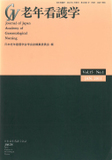Japanese
English
- 販売していません
- Abstract 文献概要
- 参考文献 Reference
本研究の目的は,虚血性脳血管疾患により血行再建術を受けた患者の術後せん妄の発症,持続期間,重症度に関連する因子を明らかにすることである.対象は,内頸動脈内膜剝離術もしくは浅側頭動脈─中大脳動脈吻合術を受けた患者144名であった.術後せん妄の発症要因34項目およびその経過について医療記録から情報収集を行い,せん妄の発症および重症度の判定は,日本語版NEECHAM混乱・錯乱スケールを用いた.
対象者の平均年齢は65.9±9.1歳で,せん妄発症率は33.1%であった.121名に対し,せん妄の発症および重症度を目的変数とし,AICによる分析を行った結果,せん妄発症における有効な説明変数として,術前の脳血流状態,誘発因子である身体抑制,ライン類の装着数,術後睡眠障害などの影響が示唆された.これにより,せん妄の直接因子とされる脳血管疾患をもつ患者に対しても,看護介入が可能であることが示唆された.また,せん妄の重症度は,疾患の重症度,手術侵襲の大きさによる影響が示された.よって,せん妄は身体内部の異常を示す指標になり,術後の身体管理は,せん妄の重症化予防においても重要であることが示唆された.
In the present study, we investigated the risk factors and course of postoperative delirium in 144 patients who underwent either carotid endarterectomy or superficial temporal artery to middle cerebral artery bypass for ischemic cerebrovascular disease. We collected information from medical records on 34 items related to the risk factors and course of postoperative delirium. The onset and severity of delirium were determined using the Japanese version of the NEECHAM Confusion Scale.
The mean age of the subjects was 65.9 ± 9.1 years, and the incidence of delirium was 33.1%. Analysis using the Akaike information criterion was performed with the onset and severity of delirium as dependent variables for 121 patients. The results suggested that effective explanatory variables for onset of delirium, were the effects of facilitating factors as well as the preoperative status of cerebral blood flow, which is a predisposing factor. On the basis of these findings, we think that nursing intervention can be effective for patients with brain diseases who are considered to have the precipitating factors of delirium physical restraint, the number of catheters, and sleeplessness after the operation. In addition, the effects of disease severity and the extent of surgical invasion were suggestive of the severity of delirium. Delirium is an indicator of somatic abnormalities, and postoperative management of physical health is important for preventing exacerbation of delirium.
Copyright © 2011, Japan Academy of Gerontological Nursing All rights reserved.


